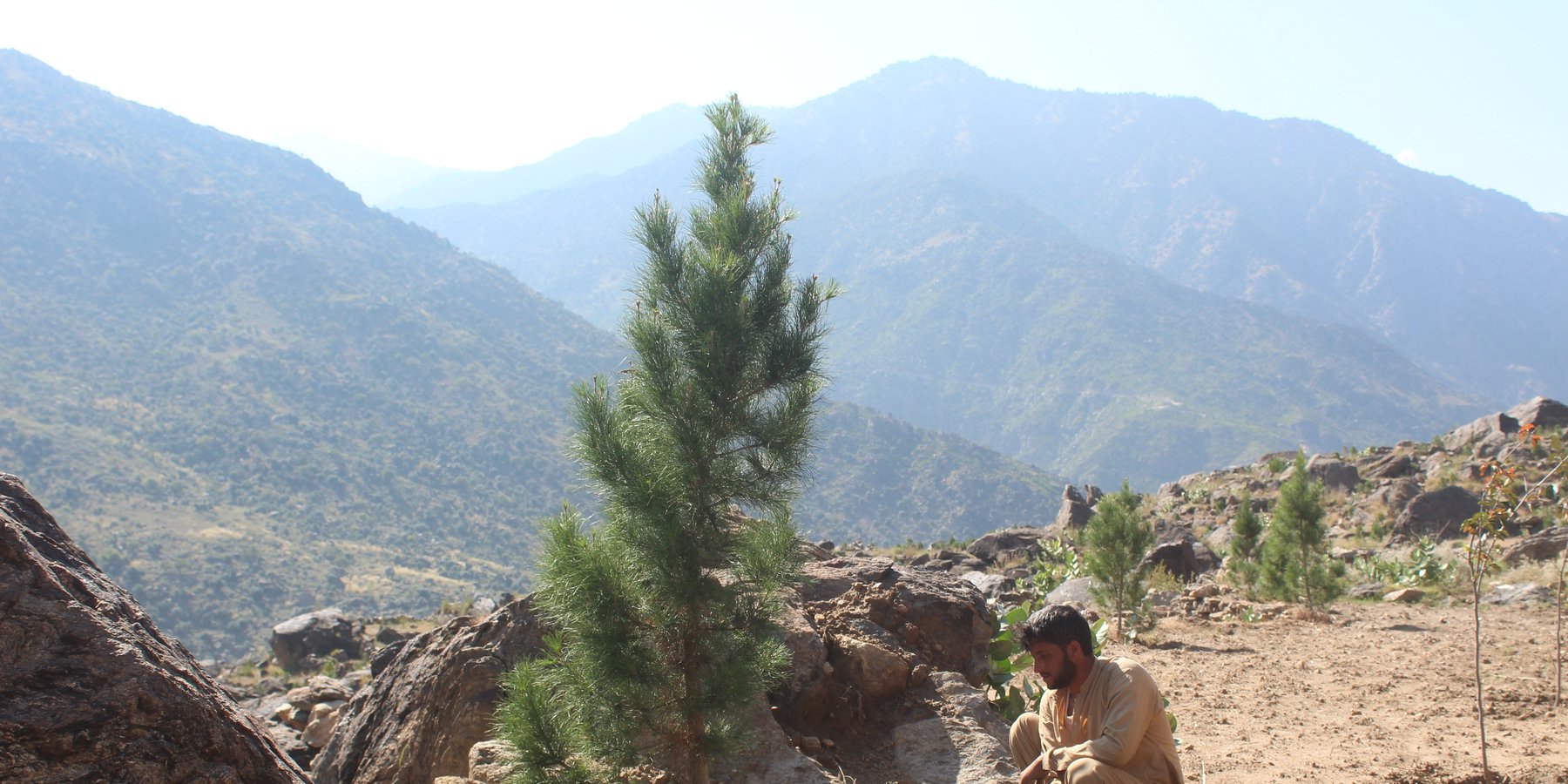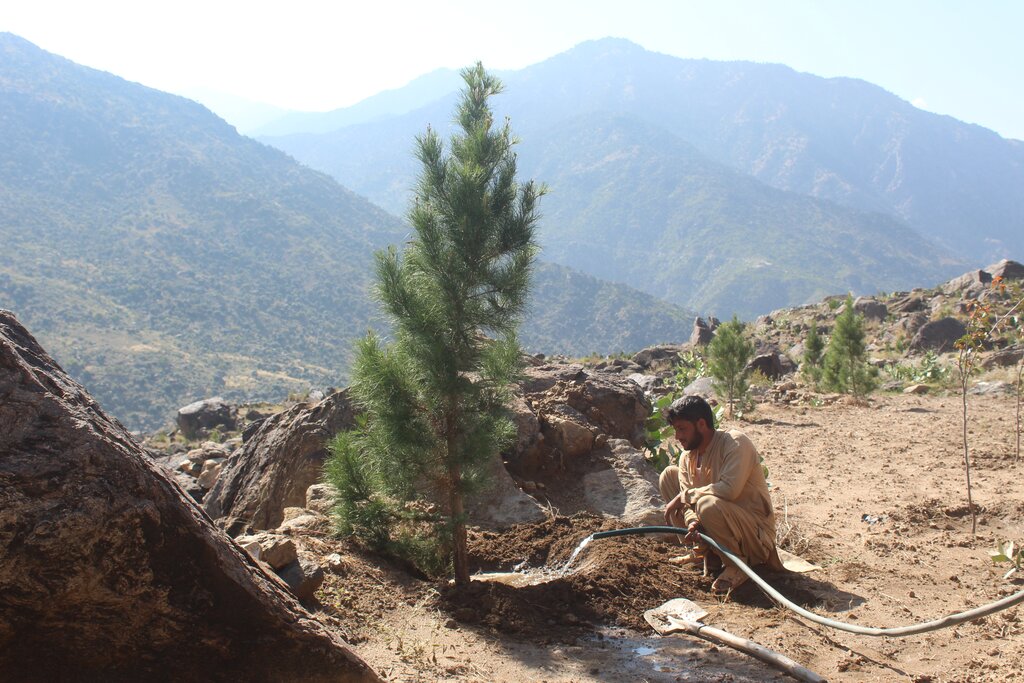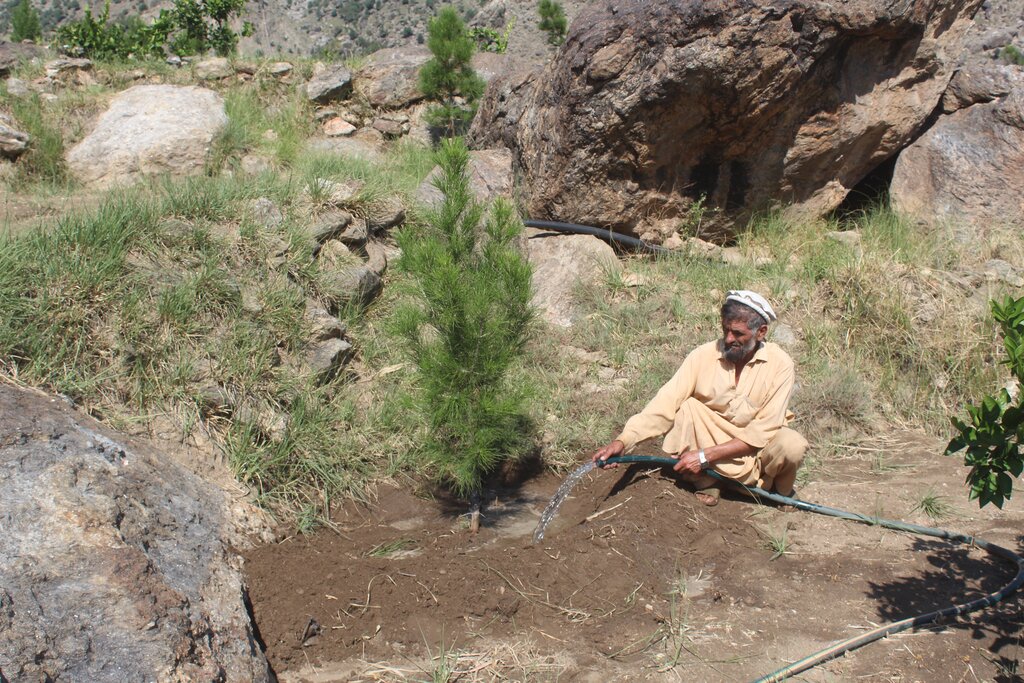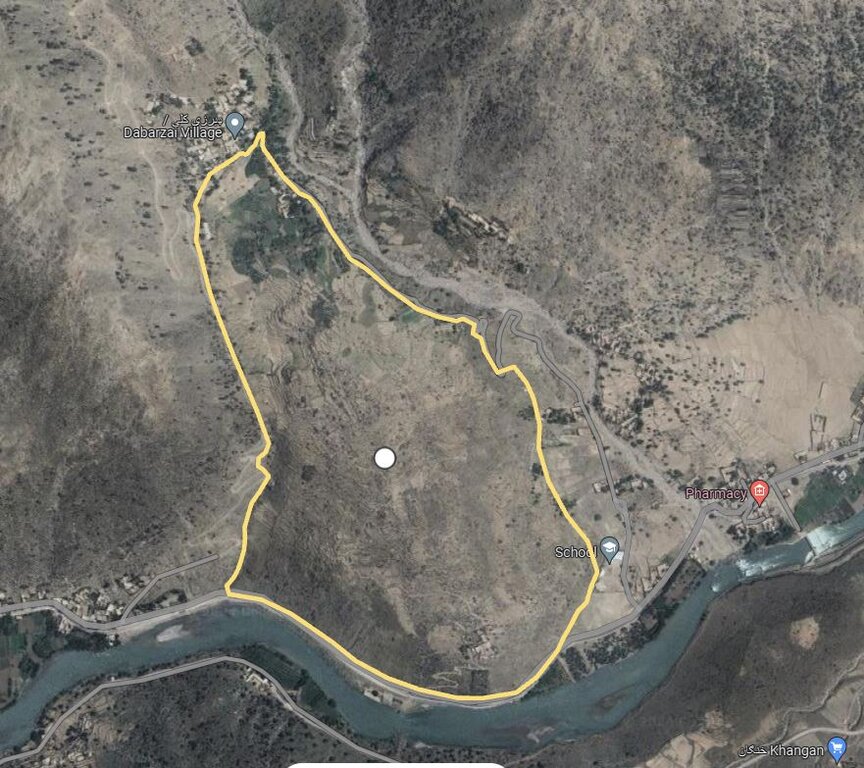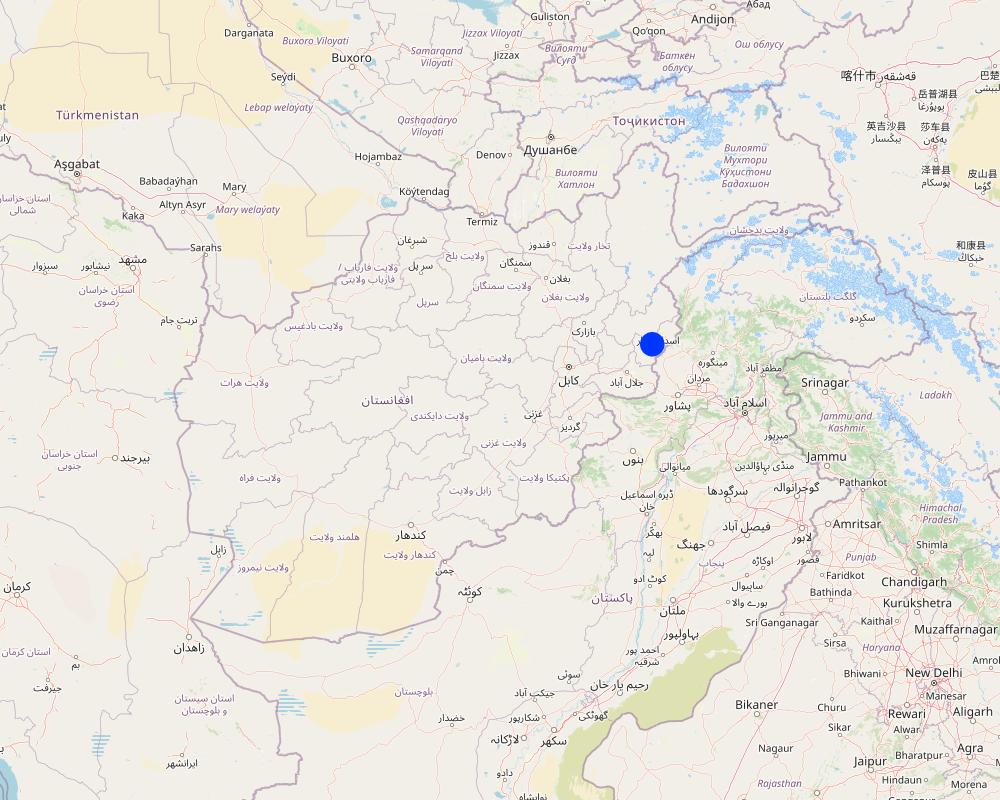Using lift irrigation for afforestation and agroforestry in Kunar [أفغانستان]
- تاريخ الإنشاء:
- تحديث:
- جامع المعلومات: Ahmad Khalid Wiyar
- المحررون: Megha bajaj, Mohammad Ajmal Rahimy, Mir Wali Khan Lakanwal
- المراجعون: Rima Mekdaschi Studer, Illias Animon, Muhammad Ishaq Safi
د ځنګل رغونی او کرنیزی ځنګلداری لپاره د پمپ په واسطه د ابه خور سیستم
technologies_7473 - أفغانستان
- Using lift irrigation for afforestation and agroforestry in Kunar: 5 مارس، 2025 (inactive)
- Using lift irrigation for afforestation and agroforestry in Kunar: 24 مارس، 2025 (inactive)
- Using lift irrigation for afforestation and agroforestry in Kunar: 18 مايو، 2025 (inactive)
- Using lift irrigation for afforestation and agroforestry in Kunar: 9 يوليو، 2025 (public)
عرض الأقسام
توسيع الكل طي الكل1. معلومات عامة
1.2 تفاصيل الاتصال بالأشخاص الرئيسيين لمصدر المعلومات والمؤسسات المشاركة في تقييم وتوثيق التقنية
الشخص (الأشخاص) الرئيسي لمصدر المعلومات
متخصص في الإدارة المستدامة للأراضي:
Safi Sharifullah
Food and Agriculture Organization of the United Nations
أفغانستان
مستخدم الأرض:
Safi Mohammad Afzal
Managi Forest Management Association (FMA)
أفغانستان
مستخدم الأرض:
Safi Qiamuddin
Managi Forest Management Association (FMA)
أفغانستان
مستخدم الأرض:
Safi Farhad
Managi Forest Management Association (FMA)
أفغانستان
اسم المشروع الذي سهّل توثيق/تقييم التقنية (إذا كان ذلك على صلة)
Community-based sustainable land and forest management in Afghanistanاسم المؤسسة (المؤسسات) التي سهلت توثيق/تقييم التقنية (إذا كان ذلك على صلة)
FAO Afghanistan (FAO Afghanistan) - أفغانستان1.3 الشروط المتعلقة باستخدام البيانات الموثقة من خلال WOCAT
يوافق جامع المعلومات والشخص (لاشخاص) الرئيسي لمصدر المعلومات على الشروط المتعلقة باستخدام البيانات الموثقة من خلال WOCAT:
نعم
1.4 إعلان بشأن استدامة التقنية الموصوفة
هل التقنية الموصوفة هنا تمثل مشكلة فيما يتعلق بتدهور الأراضي، بحيث لا يمكن إعلانها تقنية مستدامة لإدارة الأراضي؟:
كلا
التعليقات:
No, the technology described here is not problematic with regard to land degradation. In fact, it promotes sustainable land management by enhancing soil health, preventing erosion, and supporting afforestation efforts. This technology contributes to the restoration and conservation of forest ecosystems.
2. وصف تقنيةالإدارة المستدامي للأراضي
2.1 وصف مختصر للتقنية
تعريف التقنية:
Water exploitation is a major issue in Afghanistan. The lift irrigation technology helps to irrigate an afforestation/agroforestry area (demonstration plot) using surface water (rivers) and solar-powered submersible pump. The construction of reservoirs at the demo plot ensures efficient water storage and use for irrigation purposes without relying on groundwater. A well-designed pipe irrigation scheme is implemented to distribute water evenly across the site, supporting plant irrigation and growth.
2.2 وصف تفصيلي للتقنية
الوصف:
Water exploitation is a critical issue in Afghanistan, and the project aims to address this challenge through innovative and sustainable technology. The technology involves the use of solar panels and submersible water pumps to efficiently lift water from a nearby river to reservoirs constructed uphill, which is then distributed by gravity with the help of a pipe system to irrigate planted saplings in the afforested and agroforestry area. For afforestation, Pinus eldarica (Afghan pine) was planted due to its adaptability and soil stabilization properties. Additionally, citrus and persimmon trees are introduced for agroforestry, combining tree cultivation with agricultural benefits. This integrated technology promotes biodiversity, soil health, and sustainable land use, making the site a model/ demonstration site for afforestation and agroforestry practices. This is a significant advancement in the local area, utilizing clean energy to promote sustainable land and forest management and environmental restoration. The project is implemented on communal land, covering 50.25 hectares of land.
The primary purpose of this technology is to create an efficient irrigation system that extracts and transports water to support afforestation and agroforestry activities. By doing so, it aims to restore forest cover, mitigate environmental challenges such as land degradation, and promote long-term ecological and socio-economic sustainability. The technology includes key components such as solar panels, water pumps (submersible), polyvinyl chloride (PVC) pipes, water reservoirs, and saplings. Additionally, it requires labor, technical assistance, capacity-building programs, and construction materials for its establishment and maintenance.
The benefits of this technology are substantial. It has successfully irrigated previously barren land, achieving an impressive 85% survival rate for the saplings that were planted in the plot, while preventing land degradation and improving soil health. Without this technology, survival rates would drop to zero due to the arid conditions. Furthermore, the project has enhanced the capacities of local farmers/community members, enabling them to replicate and demonstrate the technology within their community. This has fostered a sense of ownership and empowerment among land users.
Land users have expressed both appreciation and concerns regarding the technology. On the positive side, they value its efficiency and reliability, as the solar panels provide a consistent water supply, especially during the hot/sunny season, leading to increased greenery and healthier trees. The cost-effectiveness of solar energy, with its low operational costs compared to traditional diesel pumps, has also been a significant advantage. Additionally, the environmentally friendly nature of the technology aligns with their desire for sustainable practices. The capacity-building programs provided by organizations like FAO have further empowered users to manage the system effectively.
However, some challenges have been noted. The initial investment costs for purchasing, installing and construction of the technology are high, making it difficult for smallholder farmers to replicate. Technical issues, such as inverter failures or battery malfunctions during extreme weather conditions (e.g., cloudy weather), can disrupt operations. Additionally, not all community members are equally informed about the technology’s benefits, highlighting the need for increased outreach and engagement efforts to ensure broader adoption and understanding.
In summary, this solar-powered irrigation technology represents a groundbreaking innovation in the area, combining clean energy with sustainable land management practices. While it has demonstrated significant environmental and agricultural benefits, addressing the challenges of initial costs, technical reliability, and community engagement will be crucial for its long-term success and scalability.
2.3 صور التقنية
2.4 فيديوهات عن التقنية
الموقع:
N/A
اسم مصور الفيديو:
N/A
2.5 البلد/المنطقة/المواقع التي تم تنفيذ التقنية فيها والتي يغطيها هذا التقييم
البلد:
أفغانستان
المنطقة/الولاية/المحافظة:
Kunar
مزيد من التفاصيل حول الموقع:
Managi village of Manogi district
حدد انتشار التقنية:
- يتم تطبيقها في نقاط محددة/ تتركز على مساحة صغيرة
هل يقع موقع/مواقع التقنية في منطقة محمية بشكل دائم؟:
كلا
التعليقات:
The area is about 50.25 ha, and the coordinate has been taken from the center of the site, where technology has been implemented:
34.9419930°N71.0119714°E
Map
×2.6 تاريخ التنفيذ
اذكر سنة التنفيذ:
2022
2.7 إدخال التقنية
حدد كيف تم إدخال التقنية:
- من خلال المشاريع/ التدخلات الخارجية
التعليقات (نوع المشروع، الخ):
GEF-06 Community based Sustainable Land and Forest Management in Afghanistan
3. تصنيف تقنية الإدارة المستدامي للأراضي
3.1 الغرض الرئيسي ( الأغراض الرئيسية) للتقنية
- تحسين الإنتاج
- الحد من تدهور الأراضي ومنعه وعكسه
- التكيف مع تغير المناخ/الظواهر المتطرفة وآثارها
- خلق أثر اقتصادي مفيد
3.2 نوع (أنواع) استخدام الأراضي الحالية حيث يتم تطبيق التقنية
استخدامات الأراضي مختلطة ضمن نفس وحدة الأرض:
نعم
حدد استخدام الأراضي المختلطة (المحاصيل / الرعي / الأشجار):
- الحراجة الزراعية

الأراضي الزراعية
- زراعة الأشجار والشجيرات
زراعة الأشجار والشجيرات -حدد المحاصيل:
- الموالح (الحمضيات)
- Persimmon
عدد مواسم الزراعة في السنة:
- 1
هل يتم ممارسة الزراعة البينية؟:
كلا
هل تتم ممارسة تناوب المحاصيل؟:
كلا

الغابات/ الأراضي الحرجية
- زراعة الأشجار، التشجير
زراعة الأشجار والتشجير: تحديد أصل وتكوين الأنواع:
- زراعة محصول واحد من صنف محلي
نوع مزارع الأشجار، التشجير:
- مزارع الغابات شبه الاستوائية الجافة-أنواع الصنوبريات
نوع الشجرة:
- أنواع الصنوبر (الصنوبر)
هل الأشجار المذكورة أعلاه ملحاء أم دائمة الخضرة؟:
- دائمة الخضرة
منتجات وخدمات:
- حفظ/حماية الطبيعة
- الترفيه / السياحة
- الحماية من المخاطر الطبيعية
3.3 هل تغير استخدام الأراضي نتيجة لتنفيذ التقنية؟
هل تغير استخدام الأراضي نتيجة لتنفيذ التقنية؟:
- نعم (يرجى ملء الأسئلة أدناه فيما يتعلق باستخدام الأراضي قبل تنفيذ التقنية)
استخدامات الأراضي مختلطة ضمن نفس وحدة الأرض:
كلا
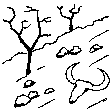
أرض غير منتجة
حدد:
5 decades ago, the area was a forest area, but due to war, smuggling and drought the area become barren land.
3.4 إمدادات المياه
إمدادات المياه للأرض التي يتم تنفيذ التقنية عليها:
- مختلط بعلي-مروي
التعليقات:
The saplings planted in the area have been supplementary irrigated. Prior to the implementation of this technology, the land was barren, and seasonal rains led to soil erosion.
3.5 مجموعةالإدارة المستدامة للأراضي التي تنتمي إليها هذه التقنية
- إدارة مزارع الغابات
- تحسين الغطاء الأرضي/النباتي
- تقنيات كفاءة الطاقة
3.6 التدابير التقنية في مجال إلادارة المستدامة للأراضي

التدابير النباتية
- V1: غطاء من الأشجار والشجيرات

التدابير البنيوية
- S5: السدود، الأحواض الصغيرة، البرك
- S7: معدات حصاد المياه/الإمداد/الري
- S10: تدابير توفير الطاقة

التدابير الإدارية
- M1: التغيير في نوع استخدام الأراضي
- M3: التخطيط وفقا للبيئة الطبيعية والبشرية
التعليقات:
The project has successfully implemented afforestation by planting trees and promoting agroforestry through the cultivation of fruit trees. To improve irrigation management, the project installed a 1-inch underground pipeline system with connected taps, enabling the attachment of flexible hoses. This efficient setup ensures optimal watering of saplings while significantly reducing water waste. By implementing this approach, the project has enhanced vegetative cover and successfully planted approximately 32,000 saplings. Additionally, the project constructed 14 rotating mounting structures for solar panels, installed 134 solar panels, established pipe schemes for manual irrigation of saplings, and constructed 6 water reservoirs with different capacities. The integration of trees at optimal spacing, combined with regular cultural practices, has further supported the project's goals.
3.7 الأنواع الرئيسية من تدهور الأراضي التي تناولتها التقنية

تآكل التربة بالمياه
- الوزن(Wt): فقدان التربة السطحية/تآكل السطح

التدهور البيولوجي
- (Bc): تناقص الغطاء النباتي
- (Bh): فقدان الموائل
- (Bl): فقدان الحياة بالتربة

تدهور المياه
- (Ha): التجفيف
- (Hg): التغير في مستوى المياه الجوفية/الطبقة المائية الجوفية
التعليقات:
The planting pits are specially designed for planting of saplings. Additionally, farmers construct small barriers near plants (eye-brows and trenches), known as micro-catchments, to collect and retain water. It is important to note that these micro-catchments are distinct structures, separate from pits and reservoirs, and are specifically built to support water retention for plants. The enhanced vegetation cover and the establishment of micro-catchments for water collection significantly reduce soil erosion. Soil improvement and enrichment, as well as habitat enhancement, are supported through these practices. Additionally, they contribute to groundwater recharge and help control runoff.
3.8 منع أو حد أو عكس تدهور الأراضي
تحديد هدف التقنية فيما يتعلق بتدهور الأراضي:
- منع تدهور الأراضي
- اصلاح/إعادة تأهيل الأراضي المتدهورة بشدة
التعليقات:
The human-induced causes of land degradation include deforestation, overgrazing of livestock, and unsustainable agricultural practices. In response, following the implementation of a specific technology, local communities established regulations rooted in their customs and traditions to protect the site, which is quarantined for five years. These regulations prohibit herders from grazing animals, cutting trees, engaging in unsustainable agricultural practices, and uprooting bushes for fuelwood. Additionally, the community has constructed rainwater harvesting structures, such as eyebrows and trenches, across the site to address natural causes of land degradation through runoff by enhancing water infiltration. As a result, the site is now effectively protected from both human-induced and natural land degradation.
4. المواصفات الفنية، وأنشطة التنفيذ، والمدخلات، والتكاليف
4.1 الرسم الفني للتقنية
المواصفات الفنية (المتعلقة بالرسم الفني):
According to the technical specifications from the project engineer, 6 reservoirs have been constructed with varying dimensions and water holding capacities as follows:
1.First reservoir: Dimension of 12x6x2 meters, with a water holding capacity of 144 m³.
2.Central reservoir: Dimensions of 16x8x2 meters, with a water holding capacity of 256 m³.
3.Four additional reservoirs: Each measuring 10x5x2 meters, with a water holding capacity of 100 m³
In total, the reservoirs will hold 800 m³ of water, ensuring a reliable water supply for irrigation of the area. Two 2-inch submersible pumps draw water from the river to supply the first reservoir. From there, two additional 2-inch submersible pumps transfer water from the first reservoir to the central reservoir. The water then flows to the other four reservoirs by gravity.
Furthermore, excavation and backfilling for 2-inch polyethylene pipes should be done to a depth of 80 cm with a width of 50 cm. For 1.5-inch pipes, excavation and backfilling should be 40 cm deep. The installation of 1.5-inch polyethylene pipes, including all elbows, joints, connectors, and valves, should be carried out every 30 meters on both sides, connecting to 1-inch pipes, in accordance with specifications and to satisfaction.
Additionally, 32,000 Pinus eldarica (Afghan Pine) and 2,500 citrus and persimmon saplings were planted across 50.25 hectares of degraded land. The saplings are spaced 5 meters apart, both plant-to-plant and row-to-row, as part of afforestation and agroforestry initiatives. This effort aims to restore ecosystems, enhance biodiversity, and improve soil conservation.
المؤلف:
Hafizullah Naeemy
التاريخ:
01/03/2022
4.2 معلومات عامة بخصوص حساب المدخلات والتكاليف
حدد كيفية احتساب التكاليف والمدخلات:
- حسب مساحة تنفيذ التقنية
الإشارة إلى حجم ووحدة المساحة:
50.25 Hectares
حدد العملة المستخدمة لحساب التكاليف:
- دولار أمريكي USD
اذكر متوسط تكلفة أجر العمالة المستأجرة في اليوم الواحد:
5 USD
4.3 أنشطة التأسيس
| النشاط | التوقيت (الموسم) | |
|---|---|---|
| 1. | Awareness and mobilization of the community | Aug-2021 |
| 2. | Survey and site selection followed by feasibility study | Sep to Oct-2021 |
| 3. | Stakeholder consultation | Aug-2021 till Sep-2022 |
| 4. | Preparation of technical design, drawings, and Bill of Quantities (BoQ). | Nov to Dec-2021 |
| 5. | Initiation of procurement process for required tools and equipment | Jan to Feb-2022 |
| 6. | Excavation and construction of water reservoirs, setting up pipe system and installation of solar panels for irrigation. | Mar to Sep-2022 |
| 7. | Capacity building of the target communities | Aug- 2021 till date |
| 8. | Practical interventions: production or purchase of saplings, digging planting pits, transplatation and irrigation of saplings and establishment of micro-catchments | Feb to Mar-2023 |
التعليقات:
The awareness-raising session on Sustainable Land Management (SLM) and Sustainable Forest Management (SFM) was successfully held to improve understanding of land and forest management practices and conservation efforts. Community members were actively mobilized to support the project, aiding in the completion of construction and installation work.
4.4 التكاليف والمدخلات اللازمة للتأسيس
| تحديد المدخلات | الوحدة | الكمية | التكاليف لكل وحدة | إجمالي التكاليف لكل مدخل | % من التكاليف التي يتحملها مستخدمو الأراضي | |
|---|---|---|---|---|---|---|
| العمالة | Unskilled labor for planting of saplings | Man/day | 450,0 | 5,0 | 2250,0 | 100,0 |
| العمالة | Skilled labor for installation of irrigation system and constuction of reservoirs | Man/day | 50,0 | 10,0 | 500,0 | |
| معدات | Water Pump 2 inch - 10HP/7500w | Number | 4,0 | 450,0 | 1800,0 | |
| معدات | Solar Panel minimum size 400W and 270W | Number | 132,0 | 82,0 | 10824,0 | |
| معدات | DC to AC Inverter 7.5-11KW | Number | 4,0 | 450,0 | 1800,0 | |
| معدات | Polyethylene Pipes 2 Inch and 1.5 Inch with all elbows, joints, connectors and valves after 30 meter for both sides to connect pipes. | Meter | 4300,0 | 2,75 | 11825,0 | |
| معدات | Rotating PV panels mounting structure (manual) | Number | 28,0 | 270,0 | 7560,0 | |
| معدات | DC and AC current wire | Meter | 1800,0 | 2,5 | 4500,0 | |
| معدات | Distribution board | Number | 2,0 | 70,0 | 140,0 | |
| معدات | Flexon 1 inch rubberize pipes | Meter | 5500,0 | 1,4 | 7700,0 | |
| المواد النباتية | Saplings procured & transported | Sapling | 32000,0 | 0,775 | 24800,0 | |
| المواد النباتية | Planting tools | lump sum | 1,0 | 500,0 | 500,0 | 100,0 |
| الأسمدة والمبيدات الحيوية | Organic fertilizers for transplanted saplings added through community | Kg | 16000,0 | 0,1 | 1600,0 | 100,0 |
| مواد البناء | 6 reservoirs constructed by a construction company (cement, stone, sand excavation, etc.. | lump sum | 1,0 | 35000,0 | 35000,0 | |
| غير ذلك | Patrolling, irrigating and quarantine of the site | lump sum | 1,0 | 1000,0 | 1000,0 | 100,0 |
| إجمالي تكاليف إنشاء التقنية | 111799,0 | |||||
| إجمالي تكاليف إنشاء التقنية بالدولار الأمريكي | 111799,0 | |||||
إذا تحمل مستخدم الأرض أقل من 100% من التكاليف، حدد من قام بتغطية التكاليف المتبقية:
The remining cost were covered by the project.
التعليقات:
The first two 2-inch submersible pumps draw water from the river to supply the first reservoir. From there, two additional 2-inch submersible pumps transfer water from the first reservoir to the central reservoir. The water then flows to the other four reservoirs through gravity.
4.5 الصيانة/الأنشطة المتكررة
| النشاط | التوقيت/الوتيرة | |
|---|---|---|
| 1. | Cleaning of sedimentation of reservoirs | Spring/annually |
| 2. | Patrolling | All seasons/regular |
| 3. | Repairing solar system & water pump (submersible) | Ad hoc /Annually |
| 4. | Plot maintenance (Pest-diseases control, mulching, weeding,). | Spring & Automn/annually |
| 5. | Replacement of failed saplings | Feb/two times (1st & 2nd year) |
| 6. | Repairing micro-catchments | Spring/annually |
4.6 التكاليف والمدخلات اللازمة للصيانة/للأنشطة المتكررة (سنويًا)
| تحديد المدخلات | الوحدة | الكمية | التكاليف لكل وحدة | إجمالي التكاليف لكل مدخل | % من التكاليف التي يتحملها مستخدمو الأراضي | |
|---|---|---|---|---|---|---|
| العمالة | Labor for cleaning of sedimentation of reservoirs | Man/day | 60,0 | 5,0 | 300,0 | 100,0 |
| العمالة | Labor for patrolling | Man/day | 360,0 | 5,0 | 1800,0 | 100,0 |
| العمالة | Labor for repairing micro-catchments | Man/day | 20,0 | 5,0 | 100,0 | 100,0 |
| العمالة | Manage the solar system operations | Man/day | 360,0 | 2,77 | 997,2 | 100,0 |
| العمالة | Labor for weeding and mulching | Man/day | 30,0 | 5,0 | 150,0 | 100,0 |
| معدات | Pump submersible, PVC pipe, fittings | lumpsum | 3,0 | 500,0 | 1500,0 | 100,0 |
| معدات | Shovels | lumpsum | 1,0 | 140,0 | 140,0 | 100,0 |
| المواد النباتية | saplings | Sapling | 2000,0 | 0,6 | 1200,0 | 100,0 |
| الأسمدة والمبيدات الحيوية | Organic fertilizers (cows dungs) | Kg | 16000,0 | 0,1 | 1600,0 | 100,0 |
| إجمالي تكاليف صيانة التقنية | 7787,2 | |||||
| إجمالي تكاليف صيانة التقنية بالدولار الأمريكي | 7787,2 | |||||
التعليقات:
The community has hired an individual to manage the solar system operations. This person is responsible for both operating the solar system for lifting water and overseeing the distribution of water for irrigation purposes among community members.
4.7 أهم العوامل المؤثرة على التكاليف
قدم وصفا لأهم العوامل التي تؤثر على التكاليف:
All equipment are imported and has resulted into higher cost.
Natural hazards, floods and windstorms will increase the costs of repairs and replacement
5. البيئة الطبيعية والبشرية
5.1 المناخ
هطول الأمطار السنوي
- < 250 مم
- 251- 500 ملم
- 501 - 750ملم
- 1,000-751 ملم
- 1,500-1,100 ملم
- 2,000-1,500 ملم
- 3,000-2,001 ملم
- 4,000-3,100 ملم
- > 4000 ملم
حدد متوسط هطول الأمطار السنوي (إذا كان معروفًا)، بالملليمتر:
300,00
المواصفات/التعليقات على هطول الأمطار:
Most of rain occur in the months of Feb, Mar, Apr, July and Aug.
الإشارة إلى اسم محطة الأرصاد الجوية المرجعية المعنية:
The data has been collected based on the farmers observation and local practices.
المنطقة المناخية الزراعية
- شبه قاحلة
5.2 طوبوغرافيا
متوسط الانحدارات:
- مسطح (0-2%)
- بسيط (3-5%)
- معتدل (6-10%)
- متدحرج (11-15%)
- تلال (16-30%)
- شديدة الانحدار(31-60%)
- فائقة الانحدار (>60%)
التضاريس:
- هضاب/سهول
- أثلام مرتفعة
- المنحدرات الجبلية
- منحدرات التلال
- منحدرات في السفوح
- قاع الوادي
المنطقة الارتفاعية:
- 100-0 متر فوق سطح البحر
- 500-101 متر فوق سطح البحر
- 1,000-501 متر فوق سطح البحر
- 1,500-1,001 متر فوق سطح البحر
- 2,000-1,501 متر فوق سطح البحر
- 2,500-2,100 متر فوق سطح البحر
- 3,000-2,501 متر فوق سطح البحر
- 4,000-3,001 متر فوق سطح البحر
- > 4000 متر فوق سطح البحر
وضح ما إذا كانت التقنية مطبقة على وجه التحديد في:
- حالات مقعرة
5.3 التربة
متوسط عمق التربة:
- ضحل جدًا (0-20 سم)
- ضحلة (21-50 سم)
- متوسطة العمق (51-80 سم)
- عميقة (81-120 سم)
- عميقة جدًا (> 120 سم)
قوام التربة (التربة السطحية):
- متوسط ( طميي، سلتي)
قوام التربة (> 20 سم تحت السطح):
- متوسط ( طميي، سلتي)
المواد العضوية في التربة السطحية:
- منخفضة (<1%)
5.4 توافر المياه ونوعيتها
منسوب المياه الجوفية:
> 50 م
توافر المياه السطحية:
متوسط
نوعية المياه (غير المعالجة):
مياه شرب جيدة
تشير جودة المياه إلى:
المياه الجوفية والسطحية
هل تعتبر ملوحة الماء مشكلة؟:
كلا
هل تحدث فيضانات في المنطقة؟:
نعم
الإنتظام:
مرارًا
5.5 التنوع البيولوجي
تنوع الأنواع:
- متوسط
تنوع الموائل:
- متوسط
5.6 خصائص مستخدمي الأراضي الذين يطبقون التقنية
مستقر أو مرتحل:
- غير المترحل
التوجه السوقي لنظام الإنتاج:
- مختلط (كفاف/ تجاري)
الدخل من خارج المزرعة:
- أقل من % 10من كامل الدخل
المستوى النسبي للثروة:
- ضعيف
أفراداً أو مجموعات:
- المجموعات/ المجتمع المحلي
مستوى المكننة:
- عمل يدوي
الجنس:
- رجال
عمر مستخدمي الأرضي:
- متوسط العمر
5.7 متوسط مساحة الأرض التي يستخدمها مستخدمو الأراضي الذين يطبقون التقنية
- < 0.5 هكتارا
- 0.5 - 1 هكتار
- 1 -2 هكتار
- 2 - 5 هكتار
- 5 - 15 هكتار
- 15 - 50 هكتار
- 50 - 100هكتار
- 500-100 هكتار
- 1,000-500 هكتار
- 10,000-1,000 هكتار
- > 10,000 هكتار
هل يعتبر هذا نطاقًا صغيرًا أو متوسطًا أو واسعا (في إشارة إلى السياق المحلي)؟:
- على نطاق صغير
التعليقات:
The area where the technology is applied covers 50.25 hectares and is managed by 112 land users.
5.8 ملكية الأراضي، وحقوق استخدام الأراضي، وحقوق استخدام المياه
ملكية الارض:
- مجتمعي/قروي
- فردية، يوجد سند ملكية
حقوق استخدام الأراضي:
- مجتمعي (منظم)
- فردي
حقوق استخدام المياه:
- مجتمعي (منظم)
- فردي
هل تعتمد حقوق استخدام الأراضي على نظام قانوني تقليدي؟:
نعم
حدد:
In Afghanistan, the traditional land use system involves the equitable distribution of deserts and barren land among the local residents. The decisions made by the elders are respected and adhered to by all members of the community.
5.9 الوصول إلى الخدمات والبنية التحتية
الصحة:
- ضعيف
- معتدل
- جيد
التعليم:
- ضعيف
- معتدل
- جيد
المساعدة التقنية:
- ضعيف
- معتدل
- جيد
العمل (على سبيل المثال خارج المزرعة):
- ضعيف
- معتدل
- جيد
الأسواق:
- ضعيف
- معتدل
- جيد
الطاقة:
- ضعيف
- معتدل
- جيد
الطرق والنقل:
- ضعيف
- معتدل
- جيد
مياه الشرب وخدمات الصرف الصحي:
- ضعيف
- معتدل
- جيد
الخدمات المالية:
- ضعيف
- معتدل
- جيد
6. الآثار والتصريحات الختامية
6.1 الآثار التي أظهرتها التقنية في الموقع
الآثار الاجتماعية والاقتصادية
الإنتاج
إنتاج المحاصيل
الكمية قبل الإدارة المستدامة للأراضي:
0
الكمية بعد الإدارة المستدامة للأراضي:
fruit production (citrus and persimmon)
التعليقات/ حدد:
The 2500 citrus and persimmon saplings have been planted as part of the agroforestry system and will bear fruit in line with the demand and needs of the people. Based on the production, the socio-economic status of the community members is expected to improve.
إنتاج الخشب
الكمية قبل الإدارة المستدامة للأراضي:
0
الكمية بعد الإدارة المستدامة للأراضي:
A total of 32,000 forest saplings (Pinus species) were successfully planted
التعليقات/ حدد:
32,000 Pinus eldarica (Afghani pine) and 2,500 citrus and persimmon saplings have been planted across 50.25 hectares of degraded land. Following agronomic practices, the four Ds—dead, diseased, damaged, and dying—branches will be pruned and utilized for shelter and fuel.
منطقة الإنتاج
الكمية قبل الإدارة المستدامة للأراضي:
0 fruit trees
الكمية بعد الإدارة المستدامة للأراضي:
Approximately 1,200 fruit trees, including sweet orange and persimmon species, have been planted
التعليقات/ حدد:
The 2500 citrus and persimmon saplings have been planted as a agroforestry and will bear fruit in line with the demand and needs of the people.
إدارة الأراضي
التعليقات/ حدد:
The area was once barren and occasionally used for rainfed cultivation, where most farmers grew wheat. Now, with the introduction and implementation of the technology farmers can also intercrop beans, mung beans, and others. Farmers who have more than 1 hectare of land hire labor for agronomical practices.
توافر المياه ونوعيتها
توافر مياه الري
الكمية قبل الإدارة المستدامة للأراضي:
0
الكمية بعد الإدارة المستدامة للأراضي:
100%
التعليقات/ حدد:
With the adoption of this technology, irrigation for planted saplings is now available 100% throughout all seasons of the year.
الدخل والتكاليف
تنوع مصادر الدخل
التعليقات/ حدد:
Timber Production, Non-Timber Forest Products, Ecotourism, Agroforestry, Wildlife Conservation and Fuelwood and Biomass
الآثار الاجتماعية والثقافية
الفرص الترفيهية
التعليقات/ حدد:
Recreational opportunities that benefit both local communities and visitors such as nature trails allowed individuals to engage with nature, promoting physical activity and wellness. The reforestation efforts have led to the restoration of habitats for various wildlife species, this provides opportunities for wildlife observation and photography, and contributing to local ecotourism.
المعرفة بالإدارة المستدامة للأراضي/تدهور الأراضي
التعليقات/ حدد:
Improved due to workshops and on job trainings
الآثار الايكولوجية
دورة المياه / الجريان السطحي
الجريان السطحي
التعليقات/ حدد:
Due to better soil coverage by plantation of saplings and micro-catchment structures
التربة
رطوبة التربة
التعليقات/ حدد:
Due to the availability of irrigation water and the establishment of micro-catchments to harvest water and enhance water infiltaration soil moisture for sapling growth has increased
غطاء التربة
التعليقات/ حدد:
Due to natural regeneration and plantation of saplings and intercrops
فقدان التربة
التعليقات/ حدد:
Due to better soil coverage and less water runoff
التنوع البيولوجي: الغطاء النباتي، الحيوانات
الغطاء النباتي
الكتلة الحيوية/ طبقة الكربون فوق التربة
التنوع النباتي
الحد من مخاطر المناخ والكوارث
آثار الفيضانات
التعليقات/ حدد:
better soil cover reduced water runoff and ultimately flooding
6.2 الآثار التي أظهرتها التقنية خارج الموقع
الضرر على البنية التحتية العامة/ الخاصة
التعليقات/ حدد:
Soil erosion was reduced and has been better controlled
آثار الغازات الدفيئة
التعليقات/ حدد:
Due to plantation
6.3 تعرض التقنية وحساسيتها لتغير المناخ التدريجي والظواهر المتطرفة/الكوارث المرتبطة بالمناخ (كما يراها مستخدمو الأراضي)
تغير مناخ تدريجي
تغير مناخ تدريجي
| الموسم | زيادة أو نقصان | كيف تتعامل التقنية مع ذلك؟ | |
|---|---|---|---|
| درجة الحرارة السنوية | زيادة | باعتدال | |
| هطول الأمطار السنوي | زيادة | باعتدال | |
| هطول الأمطار الموسمية | الربيع | زيادة | باعتدال |
الظواهر المتطرفة / الكوارث المرتبطة بالمناخ
الكوارث الجوية
| كيف تتعامل التقنية مع ذلك؟ | |
|---|---|
| عاصفة هوائية محلية | باعتدال |
6.4 تحليل التكلفة والعائد
كيف يمكن مقارنة العوائد نسبة لتكاليف الإنشاء (من وجهة نظر مستخدمي الأراضي)؟
عوائد قصيرة الأجل:
إيجابي قليلا
عوائد طويلة الأجل:
ايجابي جدا
كيف تتم مقارنة العوائدمع كلفة الصيانة/التكاليف المتكررة (من وجهة نظر مستخدمي الأراضي)؟
عوائد قصيرة الأجل:
إيجابي قليلا
عوائد طويلة الأجل:
ايجابي جدا
6.5 اعتماد التقنية
- 1-10%
من بين جميع الذين تبنوا التقنية، كم عدد الذين فعلوا ذلك بشكل تلقائي، أي دون تلقي أي حوافز مادية/مدفوعات؟:
- 10-0%
التعليقات:
The community economic condition is not good. So, without receiving incentives they are not able to adopt such technology easily.
6.6 التكيف
هل تم تعديل التقنية مؤخرًا لتتكيف مع الظروف المتغيرة؟:
كلا
6.7 نقاط القوة / المزايا / الفرص التي توفرها التقنية
| نقاط القوة/ المزايا/ الفرص من وجهة نظر مستخدمي الأراضي |
|---|
| Improved water availability with minimized fuel cost and decreased pollution as well as minimum operational cost |
| Opportunities/ potential for upscaling of the technology |
| Use of clean energy to contribute to mitigate climate change |
| Reduce greenhouse emission through carbon sequestration |
| نقاط القوة/ المزايا/ الفرص من وجهة نظر جامع المعلومات أو غيره من الاشخاص الرئيسيين لمصدر المعلومات |
|---|
| The technology is highly efficient and suitable for adoption by land users. It promotes clean energy, reduces greenhouse gas emissions through carbon sequestration, and contributes to climate change adaptation. |
| The area has been successfully afforested, restoring its natural beauty and original landscape. |
| The vegetation cover on the previously degraded land has been significantly enhanced. |
| This technology with its approach for implementation represents an effective solution for the restoration of degraded soils. |
6.8 نقاط ضعف / مساوىء / مخاطر التقنية وسبل التغلب عليها
| نقاط الضعف/ المساوىء/ المخاطر من وجهة نظر مستخدم الأراضي | كيف يمكن التغلب عليها؟ |
|---|---|
| Inadequate maintenance and repair services of the technology | Linkage to the service provider and maintenance services. Nation wide technology transfer |
| Solar water lifting relies on fully sunny days for operation, which can sometimes be a limitation, especially when weather conditions are cloudy or during periods of low sunlight. This can result in insufficient water being lifted to meet the irrigation needs of the site. | Backup charging system/battery system |
| نقاط الضعف/ المساوىء/ المخاطر من وجهة نظر جامع المعلومات أو غيره من الاشخاص الرئيسيين لمصدر المعلومات | كيف يمكن التغلب عليها؟ |
|---|---|
| Solar water lifting depends on sunny days for operation, which can sometimes fall short of meeting irrigation needs during cloudy periods. | Combining solar power with backup energy (like batteries or grid connection) |
7. المراجع والروابط
7.1 طرق جمع/مصادر المعلومات
- زيارات ميدانية، مسوحات ميدانية
10
- مقابلات مع مستخدمي الأراضي
15
- مقابلات مع المتخصصين/الخبراء في الإدارة المستدامة للأراضي
2
متى تم تجميع البيانات (ميدانيا)؟:
28/11/2024
التعليقات:
The data has been collected during Oct and Nov 2024
الروابط والوحدات المواضيعية
توسيع الكل طي الكلالروابط
لا يوجد روابط
الوحدات المواضيعية
لا يوجد وحدات مواضيعية


